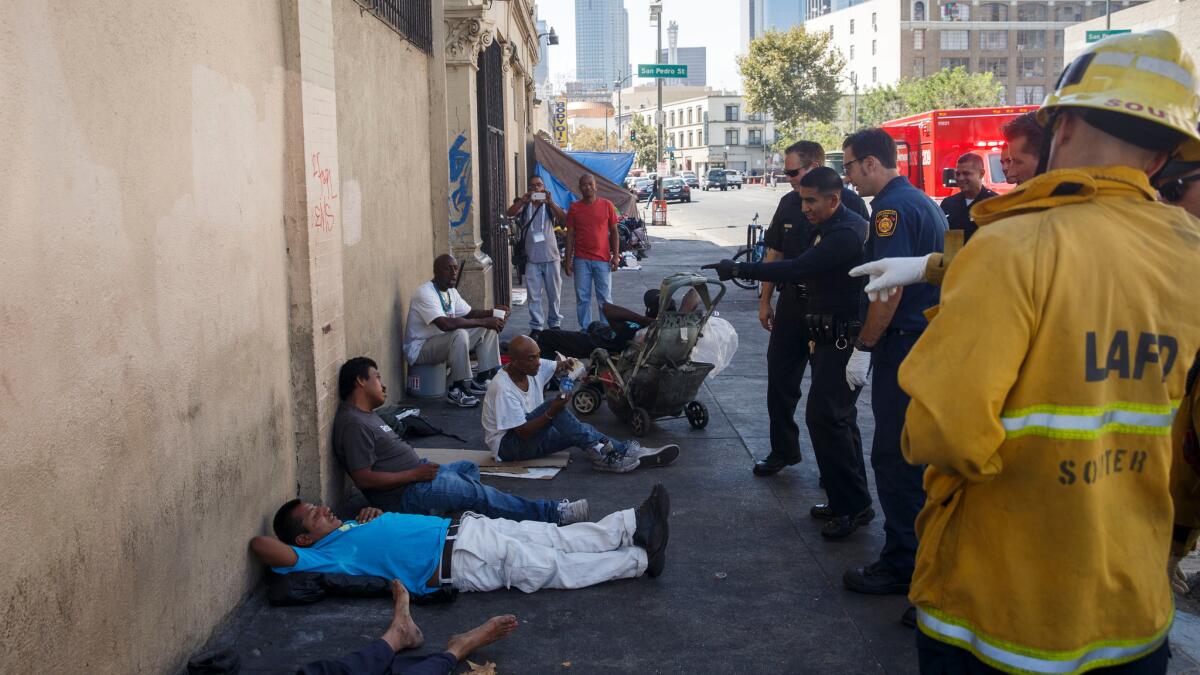Opinion: Gentrification on skid row? We should be so lucky

In a time of skyrocketing rents and stagnant income growth, the specter of gentrification hangs over working-class neighborhoods throughout Los Angeles. Residents of Boyle Heights warily view the construction cranes dotting the downtown skyline, seeing them as harbingers of change for their predominantly minority neighborhood. Similar sentiments are being espoused by residents of Historic South Central and Koreatown.
Some advocates have even warned of the impending gentrification of skid row.
In this case, we should be so lucky. Rather than pushing out the city’s most vulnerable residents, building market-rate housing on skid row could be an important step toward securing those residents the help they need while simultaneously combating our city’s growing housing crisis.
An estimated 2,000 people live on the streets and sidewalks of skid row. Men and women sleep and die in an environment littered with hypodermic needles, feces, urine, vomit and blood. In 2013, a new strain of tuberculosis originated in skid row and caused an outbreak. The CEO of the Union Rescue Mission has lost the use of his legs because of an infection he says he contracted while walking the streets with an open blister. Skid row’s concentration of poor, desperate and often mentally ill individuals makes convenient cover for violent crimes. LAPD statistics show that reported cases of aggravated assault and robbery increased by more than 70% between 2014 and 2015. Incidents of rape exploded by over 90% during the same time.
In the midst of these horrific conditions, the possibility of non-subsidized housing has added the fear of displacement to the neighborhood’s many concerns.
Consider, however, that the potential for market-rate housing in skid row is severely limited by zoning, which reflects the neighborhood’s past as an industrial hub. In the near-term future, there is little chance that the area will suddenly find itself filled with the type of mixed-use apartment buildings rising in other parts of downtown. Skid row’s zoning does not allow for that type of construction, nor have market conditions progressed to the point where for-profit developers are routinely targeting the neighborhood.
Current opportunities for additional housing are mostly limited to what’s called adaptive reuse, turning existing buildings into housing units.
There are only two market-rate housing developments of this variety proposed within the 50-block area traditionally defined as skid row. The first, planned at San Pedro and Winston streets, would convert the remainder of a building that already is partially in use as live-work lofts. The other, slated for a group of century-old structures on 5th Street, would provide 160 small studio apartments — including 28 for military veterans — priced at roughly $900 per month. The buildings were used for alcohol and drug rehabilitation beginning in the 1940s but have been vacant for several years.
Projects such as these, though controversial, may be exactly what skid row needs.
First, these developments would offer moderately priced residential units at a time when Los Angeles has become — by some metrics — the nation’s least affordable housing market. As our housing supply has failed to keep pace with increased demand since the mid-1980s, rising rents are forcing many Angelenos onto the streets. These projects would provide a small measure of relief for apartment hunters and also push the city closer toward its goal of ending veteran homelessness.
Second, adaptive reuse projects such as these take vacant, blighted properties and create new housing without the sting of displacement. Restoring them to active use would put more eyes on the street and improve the safety and aesthetics of the surrounding neighborhood. The hundreds of new residents the properties would bring would in turn allow for the establishment of markets, shops and restaurants in a place largely devoid of such amenities.
These developments can easily sit side by side with existing affordable housing stock, which is protected by covenant and not threatened by market-rate apartments. The same goes for skid row’s numerous service providers, most of which own their properties and are not in danger of displacement.
In a way, skid row advocates should be grateful for the revitalization of downtown Los Angeles. The recent crusade for $1.8 billion in municipal bond money to house the homeless has come about partly because of the experiences of a high-ranking city official who lives near Pershing Square. Extending development east into skid row can further this cause, by forcing the city to confront the heart of the problem.
Many see market-rate housing as a bellwether for displacement of the homeless, many of whom have no other place to go. Handled incautiously, this could be true. However, the appalling conditions of skid row are unacceptable; we need to take steps toward ending them. Bringing some economic clout to the neighborhood adds political heft, which will be necessary to truly make a difference.
While market-rate housing is by no means a panacea for skid row’s ailments, it could serve as an important step toward ending the city’s decades-old practice of institutional neglect. Rather than segregating those perceived as socially undesirable, we should be weaving skid row back into the cultural and economic fabric of the city.
Steven Sharp is the co-founder and editor of Urbanize.LA, where he covers real estate development, architecture and urban planning. Follow on Twitter @UrbanizeLA.
Follow the Opinion section on Twitter @latimesopinion or Facebook
MORE FROM OPINION
Will our national parks survive the next 100 years?
Diversity on campus sparks protest? It’s a sign of progress.
More to Read
A cure for the common opinion
Get thought-provoking perspectives with our weekly newsletter.
You may occasionally receive promotional content from the Los Angeles Times.










